Themed collection Editors' Collection: Lithium-ion batteries and beyond - materials, processes and recycling

Graphene reinforced carbon nanofiber engineering enhances Li storage performances of germanium oxide
In the GeO2/nanocable, amorphous carbon and graphene spontaneously construct a nanocable structure, graphene “core” promises the good electrical conductivity while the amorphous carbon “shell” guarantees the fast Li ions diffusion.

RSC Adv., 2020,10, 10873-10878
https://doi.org/10.1039/D0RA00720J
Reducing interfacial resistance of a Li1.5Al0.5Ge1.5(PO4)3 solid electrolyte/electrode interface by polymer interlayer protection
Using PPC interlayers to protect the LAGP electrolyte and reduce the interfacial impedance between electrode and electrolyte.

RSC Adv., 2020,10, 10038-10045
https://doi.org/10.1039/D0RA00829J
An all solid-state Li ion battery composed of low molecular weight crystalline electrolyte
A non-polymer crystalline organoboron electrolyte results in the formation of nano-channels for directional conduction of Li ions, owing to presence of boron, allowing Lewis acid–base interaction.

RSC Adv., 2020,10, 8780-8789
https://doi.org/10.1039/C9RA09559D
Investigation of K-ion storage performances in a bismuth sulfide-carbon nanotube composite anode
The Bi2S3-CNT composite anode shows reversible K-ion storage capability through the conversion and alloying reaction steps.
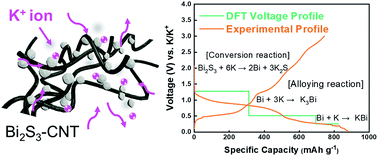
RSC Adv., 2020,10, 6536-6539
https://doi.org/10.1039/D0RA00374C
A LiPO2F2/LiPF6 dual-salt electrolyte enabled stable cycling performance of nickel-rich lithium ion batteries
The LiPO2F2/LiPF6 dual-salt electrolyte can significantly enhance the cycling performance of NCM811/Li cells.

RSC Adv., 2020,10, 1704-1710
https://doi.org/10.1039/C9RA09841K
Influence of electronically conductive additives on the cycling performance of argyrodite-based all-solid-state batteries
Low-surface-area carbon black helps to improve the performance of bulk-type all-solid-state batteries using NCM622 cathode material and argyrodite Li6PS5Cl solid electrolyte.
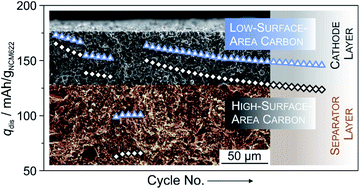
RSC Adv., 2020,10, 1114-1119
https://doi.org/10.1039/C9RA10253A
Anion effects on the solvation structure and properties of imide lithium salt-based electrolytes
The anion effect on Li+ solvation and consequent electrochemical and physical properties was studied on the basis of LiFSI-DMC and LiTFSI-DMC based dilute electrolytes, highly concentrated electrolytes, and localized concentrated electrolytes.

RSC Adv., 2019,9, 41837-41846
https://doi.org/10.1039/C9RA07824J
Asymmetrically coated LAGP/PP/PVDF–HFP composite separator film and its effect on the improvement of NCM battery performance
A LAGP/PP/PVDF–HFP double-sided asymmetric composite separator film was prepared to improve the battery performance in LIBs.

RSC Adv., 2019,9, 41151-41160
https://doi.org/10.1039/C9RA09200E
Investigation of the leaching mechanism of NMC 811 (LiNi0.8Mn0.1Co0.1O2) by hydrochloric acid for recycling lithium ion battery cathodes
This paper investigates the reactions involved when LiNi0.8Mn0.1Co0.1O2 (NMC 811), which is one of the most promising positive electrodes for the next generation of lithium-ion batteries, is leached by hydrochloric acid.
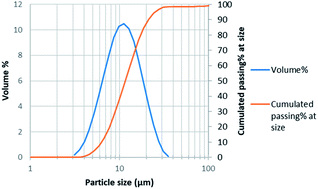
RSC Adv., 2019,9, 38612-38618
https://doi.org/10.1039/C9RA06686A
Mechanistic insight into the improved Li ion conductivity of solid polymer electrolytes
The studies shown here prove that both the Li salt and ‘inert-polymer’ mixing have paramount importance in the tunability of Li ion conductivity in solid electrolytes for batteries.
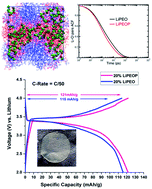
RSC Adv., 2019,9, 38646-38657
https://doi.org/10.1039/C9RA08003A
Structure and electrochemical performance modulation of a LiNi0.8Co0.1Mn0.1O2 cathode material by anion and cation co-doping for lithium ion batteries
Ni-rich layered transition metal oxides show great energy density but suffer poor thermal stability and inferior cycling performance, which limit their practical application.

RSC Adv., 2019,9, 36849-36857
https://doi.org/10.1039/C9RA07873H
Rapid synthesis of MgCo2O4 and Mg2/3Ni4/3O2 nanocrystals in supercritical fluid for Mg-ion batteries
High-quality spinel MgCo2O4 and rocksalt Mg2/3Ni4/3O2 nanocrystal cathodes allow fast extraction/insertion of magnesium ions for high energy-density batteries.

RSC Adv., 2019,9, 36717-36725
https://doi.org/10.1039/C9RA04936C
Rapid room-temperature synthesis of ultrasmall cubic Mg–Mn spinel cathode materials for rechargeable Mg-ion batteries
An ultrasmall cubic Mg–Mn spinel obtained by an alcohol reduction process is demonstrated as a cathode candidate for rechargeable Mg-ion batteries.
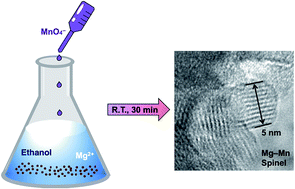
RSC Adv., 2019,9, 36434-36439
https://doi.org/10.1039/C9RA08626A
Improved lithium ion dynamics in crosslinked PMMA gel polymer electrolyte
Ionic transport was investigated in a PMMA gel electrolyte by electrochemical, Raman, PFG-NMR, e-NMR spectroscopies and ab initio calculations. The presence of the PMMA matrix reduces anionic mobility and decorrelates cationic and anionic transport.
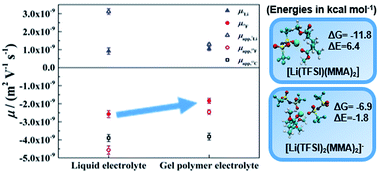
RSC Adv., 2019,9, 27574-27582
https://doi.org/10.1039/C9RA05917B
Aqueous leaching of lithium from simulated pyrometallurgical slag by sodium sulfate roasting
An effective method for the recovery of lithium from the slag formed by treating spent lithium-ion batteries.

RSC Adv., 2019,9, 23908-23915
https://doi.org/10.1039/C9RA03754C
Extraction of cobalt(II) by methyltrioctylammonium chloride in nickel(II)-containing chloride solution from spent lithium ion batteries
Interception of dearomatized tertiary boronic ester in a diastereoselective [4 + 2] cycloaddition or 1,3-borotopic shift in the presence or absence of “naked” Li+, understanding reactivities by activation/strain model, were evaluated by DFT calculations.

RSC Adv., 2019,9, 22729-22739
https://doi.org/10.1039/C9RA02719J
Impurity removal with highly selective and efficient methods and the recycling of transition metals from spent lithium-ion batteries
A strategy for metal purification and recovery from spent lithium-ion batteries is demonstrated by taking advantage of precipitation, electrodeposition and solvent extraction.
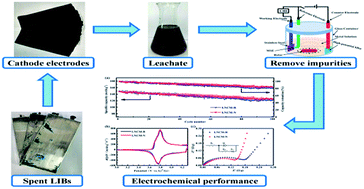
RSC Adv., 2019,9, 21922-21930
https://doi.org/10.1039/C9RA02331C
Unlocking high capacities of graphite anodes for potassium-ion batteries
Ball-milling of graphite results in graphene layer exfoliation and defect formation, leading to enhanced performance as a K-ion battery anode.

RSC Adv., 2019,9, 21070-21074
https://doi.org/10.1039/C9RA01931F
The rapid microwave-assisted hydrothermal synthesis of NASICON-structured Na3V2O2x(PO4)2F3−2x (0 < x ≤ 1) cathode materials for Na-ion batteries
NASICON-structured Na3V2O2x(PO4)2F3−2x (0 < x ≤ 1) solid solutions have been prepared using a microwave-assisted hydrothermal (MW-HT) technique.

RSC Adv., 2019,9, 19429-19440
https://doi.org/10.1039/C9RA02257K
Highly efficient & stable Bi & Sb anodes using lithium borohydride as solid electrolyte in Li-ion batteries
All solid-state Li-ion batteries using commercial Bi and Sb as negative electrodes with a high coulombic efficiency (90–99%) and high capacity retention of 82 and 95%, respectively.

RSC Adv., 2019,9, 13077-13081
https://doi.org/10.1039/C9RA01479A
Deciphering the lithium ion movement in lithium ion batteries: determination of the isotopic abundances of 6Li and 7Li
Different aging experiments were performed on NMC622/graphite cells with a 6Li enriched electrolyte to unravel the lithium distribution.
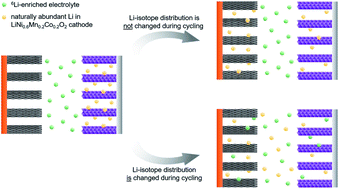
RSC Adv., 2019,9, 12055-12062
https://doi.org/10.1039/C9RA02312G
Preparation of thin solid electrolyte by hot-pressing and diamond wire slicing
The thickness of a solid electrolyte influences the performance of all-solid-state batteries due to increased impedance with a thick electrolyte.

RSC Adv., 2019,9, 11670-11675
https://doi.org/10.1039/C9RA00711C
Rechargeable aluminum batteries: effects of cations in ionic liquid electrolytes
Room temperature ionic liquids (RTILs) are solvent-free liquids comprised of densely packed cations and anions. Properties of Py13Cl–AlCl3 ILs were studied and compared with EMIC-AlCl3 ILs for use as electrolyte in Al–graphite battery.
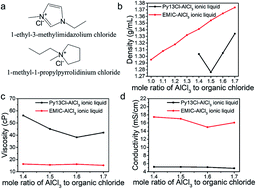
RSC Adv., 2019,9, 11322-11330
https://doi.org/10.1039/C9RA00765B
About this collection
This collection, guest-edited by Associate Editor A/Prof. Alexey Glushenkov (The Australian National University), features articles on the topic of Lithium-ion Batteries and Beyond, covering the research on battery-related materials, processes and recycling published in RSC Advances in the last two years. This exciting research field becomes more and more prominent as batteries enter new applications in electric vehicles, decarbonisation of homes and grid-scale energy storage. The selection of articles demonstrates advances in the design of components for lithium-ion batteries, emerging recycling methods for lithium-ion batteries and the efforts directed towards creating more sustainable, beyond lithium batteries.
Lithium-ion batteries are currently the dominant energy storage solution in a variety of traditional and emerging battery applications. Their attractive performance can be sustained and improved by the innovations in their electrode, electrolyte and separator materials, and by developing new processes to fabricate battery components and to monitor processes in batteries. A range of recent research publications from RSC Advances illustrate these developments, including a very exciting area of solid electrolytes. Further, with the increase in the number of batteries deployed in real-life applications, the issue of lithium-ion battery recycling emerges strongly. Examples of recycling procedures are highlighted in selected publications. At present, the battery community is also actively striving to develop beyond-lithium, sustainable batteries free of lithium and/or nickel and cobalt. The collection includes a sample of recent publications on sodium-ion (Na-ion), potassium-ion (K-ion), aluminium-ion (Al-ion) and magnesium (Mg-ion) batteries.